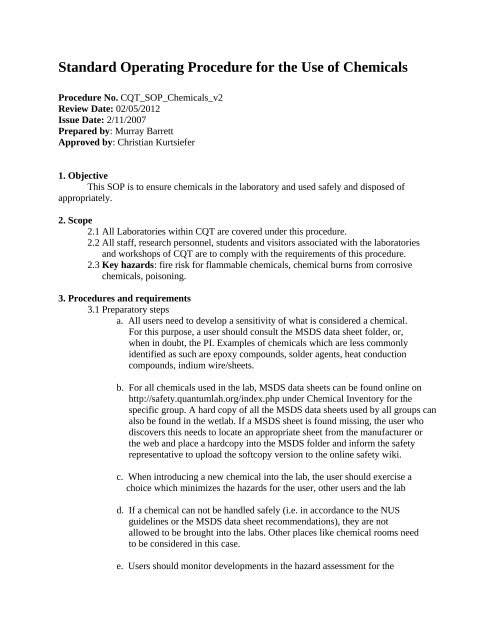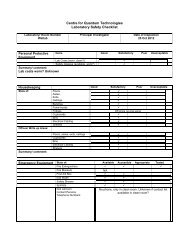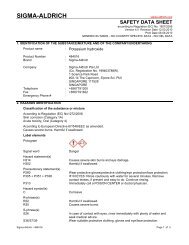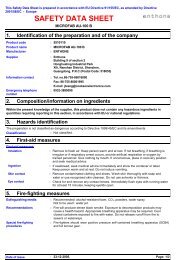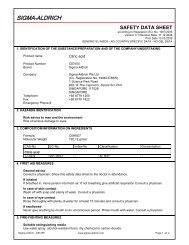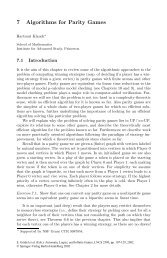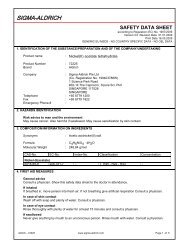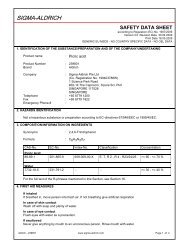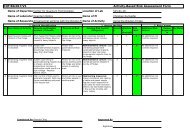Standard Operating Procedure for the Use of Chemicals
Standard Operating Procedure for the Use of Chemicals
Standard Operating Procedure for the Use of Chemicals
You also want an ePaper? Increase the reach of your titles
YUMPU automatically turns print PDFs into web optimized ePapers that Google loves.
<strong>Standard</strong> <strong>Operating</strong> <strong>Procedure</strong> <strong>for</strong> <strong>the</strong> <strong>Use</strong> <strong>of</strong> <strong>Chemicals</strong><strong>Procedure</strong> No. CQT_SOP_<strong>Chemicals</strong>_v2Review Date: 02/05/2012Issue Date: 2/11/2007Prepared by: Murray BarrettApproved by: Christian Kurtsiefer1. ObjectiveThis SOP is to ensure chemicals in <strong>the</strong> laboratory and used safely and disposed <strong>of</strong>appropriately.2. Scope2.1 All Laboratories within CQT are covered under this procedure.2.2 All staff, research personnel, students and visitors associated with <strong>the</strong> laboratoriesand workshops <strong>of</strong> CQT are to comply with <strong>the</strong> requirements <strong>of</strong> this procedure.2.3 Key hazards: fire risk <strong>for</strong> flammable chemicals, chemical burns from corrosivechemicals, poisoning.3. <strong>Procedure</strong>s and requirements3.1 Preparatory stepsa. All users need to develop a sensitivity <strong>of</strong> what is considered a chemical.For this purpose, a user should consult <strong>the</strong> MSDS data sheet folder, or,when in doubt, <strong>the</strong> PI. Examples <strong>of</strong> chemicals which are less commonlyidentified as such are epoxy compounds, solder agents, heat conductioncompounds, indium wire/sheets.b. For all chemicals used in <strong>the</strong> lab, MSDS data sheets can be found online onhttp://safety.quantumlah.org/index.php under Chemical Inventory <strong>for</strong> <strong>the</strong>specific group. A hard copy <strong>of</strong> all <strong>the</strong> MSDS data sheets used by all groups canalso be found in <strong>the</strong> wetlab. If a MSDS sheet is found missing, <strong>the</strong> user whodiscovers this needs to locate an appropriate sheet from <strong>the</strong> manufacturer or<strong>the</strong> web and place a hardcopy into <strong>the</strong> MSDS folder and in<strong>for</strong>m <strong>the</strong> safetyrepresentative to upload <strong>the</strong> s<strong>of</strong>tcopy version to <strong>the</strong> online safety wiki.c. When introducing a new chemical into <strong>the</strong> lab, <strong>the</strong> user should exercise achoice which minimizes <strong>the</strong> hazards <strong>for</strong> <strong>the</strong> user, o<strong>the</strong>r users and <strong>the</strong> labd. If a chemical can not be handled safely (i.e. in accordance to <strong>the</strong> NUSguidelines or <strong>the</strong> MSDS data sheet recommendations), <strong>the</strong>y are notallowed to be brought into <strong>the</strong> labs. O<strong>the</strong>r places like chemical rooms needto be considered in this case.e. <strong>Use</strong>rs should monitor developments in <strong>the</strong> hazard assessment <strong>for</strong> <strong>the</strong>
chemicals <strong>the</strong>y handle on a more frequent basis.f. A user should identify <strong>the</strong> 3 most hazardous chemicals he or she handles,and familiarize with <strong>the</strong> hazards associated with that chemical.3.2 Storage and disposalg. All chemicals brought into <strong>the</strong> laboratory must be inventoried inaccordance with OSHE/SOP/GL/03.h. Chemical waste shall be disposed <strong>of</strong> in accordance withOSHE/SOP/CS/01.i. All chemical containers with capacity >200ml (<strong>for</strong> isopropanol andethanol: >500ml) must be stored in an approved safety cabinet when not inuse. Dropper bottles may be stored in working locations whereappropriate.j. Containers with chemicals shall under no circumstances be located onmessy working surfaces or within optical setups.k. Chemical should only be stored in small quantities. A guideline <strong>for</strong> what isconsidered small <strong>for</strong> a certain chemical is <strong>the</strong> quantity which will be usedduring one month.3.3 All chemical containers must be clearly labeled with <strong>the</strong>ir contents. Containerswith unreadable labeling need to be disposed according to 4.2.b3.4 Usagel. Be<strong>for</strong>e handling chemicals, a clean working surface needs to be preparedby <strong>the</strong> user to minimize contamination hazards <strong>for</strong> unrelated equipment.m. Proper working surfaces need to be chosen <strong>for</strong> handling chemicals.Untreated wooden surfaces are not to be used <strong>for</strong> handling any chemicals.Formica surfaces or surfaces which are inert to <strong>the</strong> chemical in use have tobe used.n. Appropriate gloves are to be worn whenever chemicals are handled whichrequire this. Gloves used <strong>for</strong> handling chemicals should be removed whenhandling equipment which will be used by o<strong>the</strong>r users without gloves toavoid cross contamination. Authoritative resource <strong>for</strong> such a decision is<strong>the</strong> MSDS data sheet <strong>for</strong> <strong>the</strong> chemical under question.o. Lab coat and safety goggles are to be worn when transferring chemicalsfrom storage containers to wash bottles and dropper bottles. This is aparticular concern when acids are involved.
p. Evaporation <strong>of</strong> chemicals into <strong>the</strong> room has to be avoided to minimizeexposure <strong>of</strong> <strong>the</strong> user and o<strong>the</strong>r users. Particularly, this is to be observedwith common volatile solvents like acetone, methanol and ethanol.q. Proper ventilation has to be ensured by a user handling evaporatingchemicals, e.g. by opening doors in case chemical vapours accumulate.r. Usage <strong>of</strong> fume hood when handling volatile chemicals.s. Whenever <strong>the</strong>re is a choice <strong>of</strong> using different solvents <strong>for</strong> cleaning, <strong>the</strong>choice with <strong>the</strong> least hazardous impact has to be made. Hazards <strong>for</strong> thisconcern are toxicity and flammability.t. Any accidental spill <strong>of</strong> chemicals needs to be removed immediately tokeep a clean working surface.u. Every user needs to ensure that no o<strong>the</strong>r user is unexpectedly and/orunknowingly exposed to chemicals during <strong>the</strong> normal work flow in <strong>the</strong>lab. Examples are e.g. unlabeled exposure <strong>of</strong> surfaces coated with epoxyresins, or microscope slides coated with non-fixated chemicals.3.5 Instructions <strong>for</strong> specific chemicals:v. Handling <strong>of</strong> acids and bases: When handling acids such as HCl, sulphuricacid, or bases like NaOH, KOH , goggles have to be worn. Dilution <strong>of</strong><strong>the</strong>se chemicals has to be done by pouring <strong>the</strong> chemical in to water, never<strong>the</strong> o<strong>the</strong>r way round.w. We should use ethanol as a first attempt and <strong>the</strong> usage <strong>of</strong> Methanol as asolvent has to be avoided wherever possible. Particularly, it should not beused in a ultrasonic cleaner.x. Gas cylinders have to be handled with <strong>the</strong> usual precautions: Properprotection against falling over (metal chain to a wall or very heavy object;example: Milling machine), usage <strong>of</strong> appropriate pressure reduction gear.3.6 Handling Mercury Spills:face1. In<strong>for</strong>m o<strong>the</strong>r people in <strong>the</strong> lab, your PI and your safety representative. Wear gloves andmask. Barricade spill area.2. Carefully pick up <strong>the</strong> larger pieces <strong>of</strong> broken glass and what remains <strong>of</strong> <strong>the</strong> brokendevice and place <strong>the</strong>m on a paper towel. Gently fold <strong>the</strong> paper towel around <strong>the</strong>se piecesso you can pick <strong>the</strong> bundle up and place it in a zipper-type plastic bag or sealable plastic-


